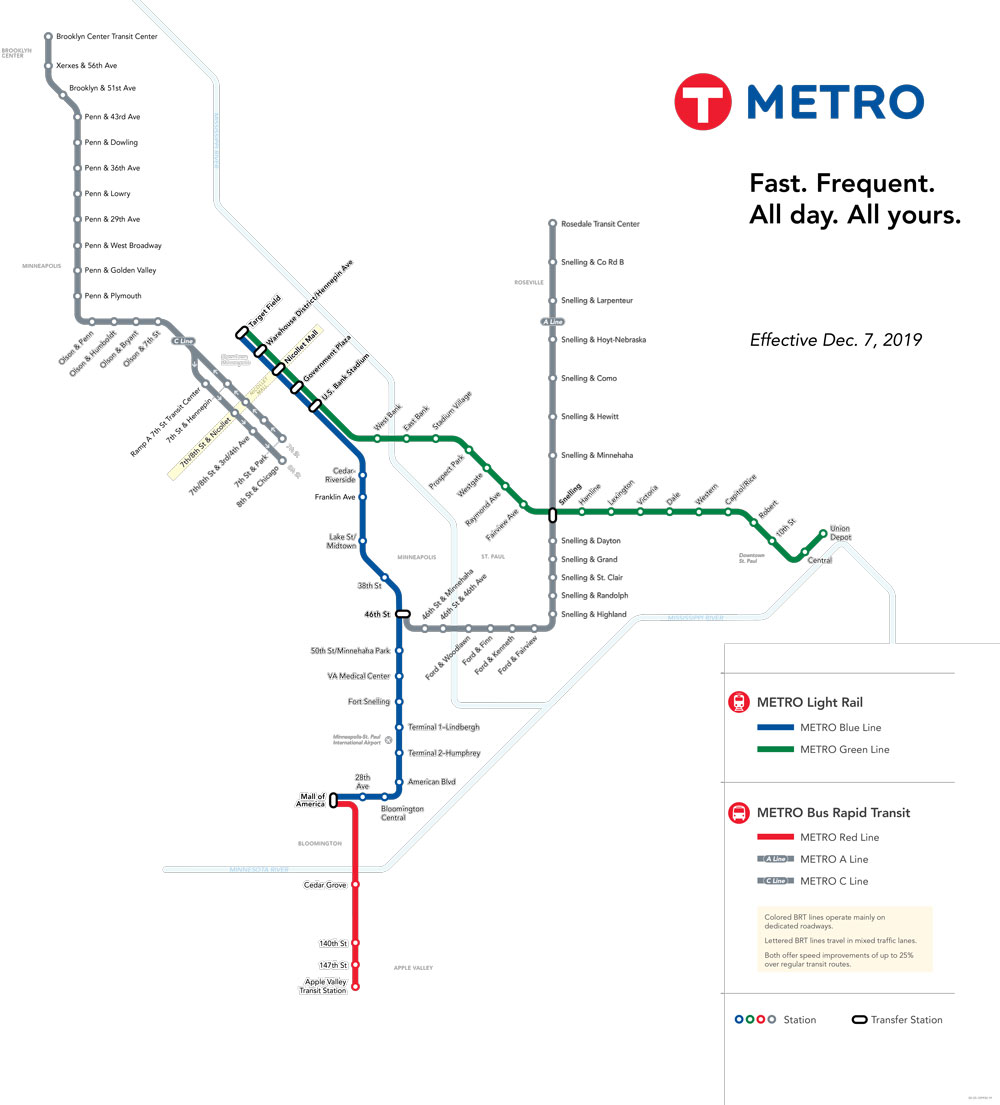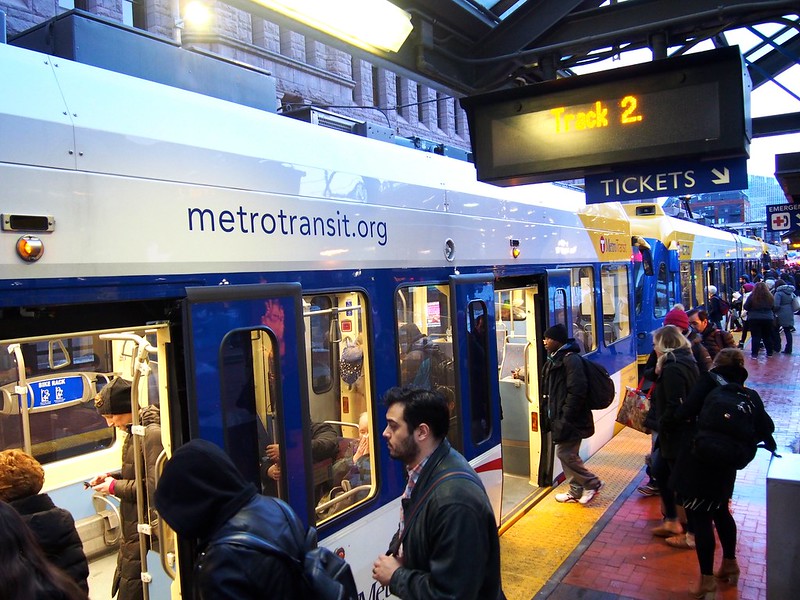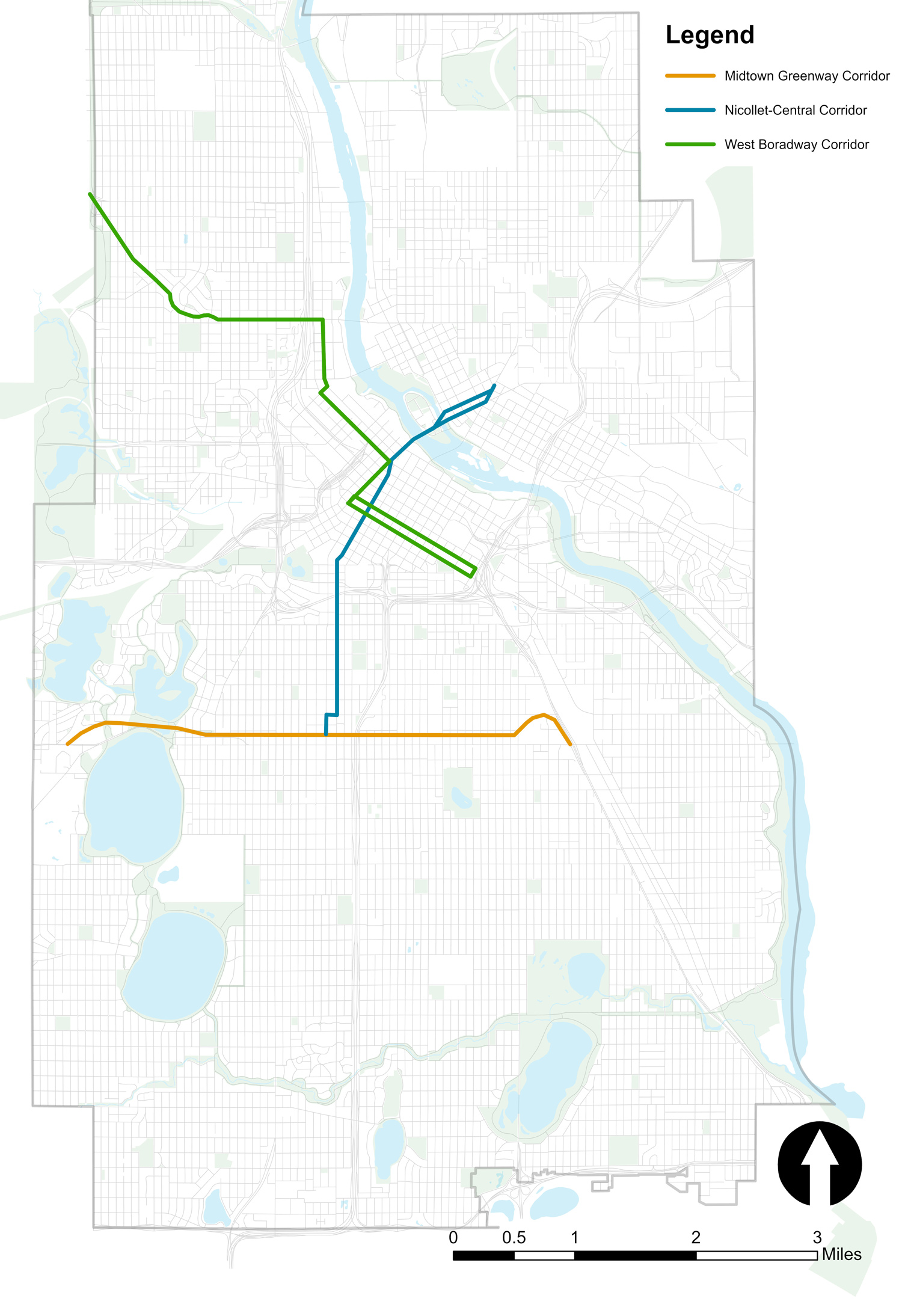Strategy 4 Partner with Metro Transit and other agencies to pursue new transit projects of high impact.
The actions within this strategy are divided into two categories:
Action we will DOActions we will SUPPORTAction we will do are followed by “DO” and are colored in dark gray, and actions we will support are followed by “SUPPORT” and are colored in light gray.
Learn more about how we get thereLight rail and bus rapid transit routes provide the major spines of the existing METRO transitway system in Minneapolis, along with one commuter rail line. Bus rapid transit service includes off-board fare payment, fewer stops compared to regular transit lines, enhanced shelters that include real-time vehicle information, and longer buses that allow for all-door boarding. Light rail service is similar but runs along dedicated rail lines. The existing light rail has routinely exceeded ridership expectations and has spurred development along the corridors. High frequency transit serves about 3% of the region by land area, but the volume of development it is capturing is significant.1
Light rail and bus rapid transit are major capital investments; however, bus rapid transit projects are less costly to build and quicker to plan and construct than light rail projects, which require a larger scale of investment and time needed for implementation. Fifty percent of the funding for design and construction of light rail and bus rapid transit projects is historically provided by the federal government. We believe that expanding the METRO transitway network is an effort worth investing in. It will be critical with any new light rail developments in Minneapolis that provisions are in place to ensure that nearby residents benefit from the transit investment, including through preservation and construction of affordable housing.
Several projects in Minneapolis have gone through early environmental review processes and have a locally preferred alternative identified. The extents of these corridors are extended below in cases, reflecting the vision of increasing high frequency transit to more people throughout the city.
Actions to partner with Metro Transit and other agencies to pursue new transit projects of high impact.
Transit 4.1
Plan, design and construct high capacity, neighborhood-based transit along the Nicollet-Central corridor.
Supported goals:
Climate Prosperity Mobility Active Partnerships
Related actions:
Difficulty:
High
Timeframe:
2020-2023 (Years 0-3)
Transit 4.2
Plan, design and construct high capacity, neighborhood-based transit within the dedicated right of way along the Midtown Greenway from West Lake Station on the METRO Green Line Extension to Lake Street Station on the METRO Blue Line.
Supported goals:
Climate Prosperity Mobility Active Partnerships
Related actions:
Difficulty:
High
Timeframe:
2024-2027 (Years 4-7)
Transit 4.3
Plan, design and construct high capacity, neighborhood-based transit along the West Broadway corridor from downtown Minneapolis to the northwest suburbs.
Supported goals:
Climate Prosperity Mobility Active Partnerships
Related actions:
Difficulty:
High
Timeframe:
2028-2030 (Years 8-10)
Transit 4.4
Advocate and provide continued support for METRO B, D, and E Bus Rapid Transit lines, and work with Metro Transit to identify and pursue additional Bus Rapid Transit Lines in Minneapolis.
Supported goals:
Climate Equity Prosperity Mobility Active Partnerships
Related actions:
Difficulty:
Low
Timeframe:
2020-2023 (Years 0-3)
Status:
On-going
Transit 4.5
Advocate and provide continued support for the METRO Blue Line Extension light rail project, connecting Minneapolis with the region’s northwestern communities. As the transit service is reevaluated, ensure new routing alignments provide high-quality service for residents of North Minneapolis and safety improvements are made to the prior alignment along Olson Memorial Highway, bringing reduced speeds and more people-focused and urban scale improvements to the corridor.
Supported goals:
Climate Prosperity Mobility Active Partnerships
Related actions:
Difficulty:
High
Timeframe:
2020-2023 (Years 0-3)
Status:
On-going
Transit 4.6
Support bus rapid transit on Olson Memorial Highway (Highway 55) extending to the region’s western communities.
Supported goals:
Climate Prosperity Mobility Active Partnerships
Related actions:
Difficulty:
Low
Timeframe:
2020-2023 (Years 0-3)
Status:
On-going
Transit 4.7
Develop long-term operations plans for new transit services in partnership with Metro Transit and other partner agencies.
Supported goals:
Climate Mobility Active Partnerships
Related actions:
Difficulty:
Medium
Timeframe:
2024-2027 (Years 4-7)
Transit 4.8
Advocate for light rail and bus rapid transitways that provide direct connections to regional job centers and other destinations outside of the downtown core within Minneapolis, connecting Minneapolis residents with the regional rail system.
Supported goals:
Prosperity Mobility Active Partnerships
Related actions:
Difficulty:
High
Timeframe:
2020-2023 (Years 0-3)
Status:
On-going
Transit 4.9
Advocate for transitway alignments that are conducive to transit-oriented development and that would include preservation, maintenance and construction of housing at all levels of affordability.
Supported goals:
Climate Equity Prosperity Mobility Active Partnerships
Related actions:
Difficulty:
Medium
Timeframe:
2020-2023 (Years 0-3)
Status:
On-going
Transit 4.10
Continue to partner with the Hennepin County Regional Railroad Authority, Metro Transit, the Minnesota Department of Transportation, and developers near Target Field Station to plan for the expansion of future commuter rail, inter-city passenger rail, and/or high-speed rail projects and supporting facilities.
Supported goals:
Equity Prosperity Mobility Active Partnerships
Related actions:
Difficulty:
High
Timeframe:
2020-2023 (Years 0-3)
Status:
On-going
Transit 4.11
Support statewide efforts to advance the Northern Lights Express (NLX) connecting Minneapolis with Duluth via high speed rail.
Supported goals:
Climate Equity Prosperity Mobility Active Partnerships
Related actions:
Difficulty:
Medium
Timeframe:
2020-2023 (Years 0-3)
Status:
On-going
See also actions:
- Transit 6.8
Integrate unique and interactive design on high impact transit projects



